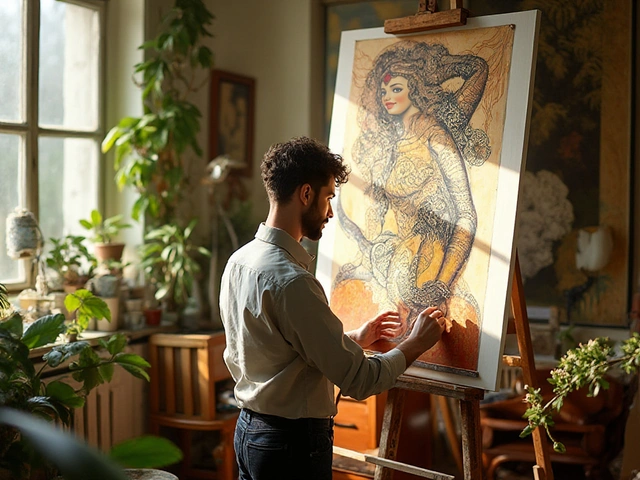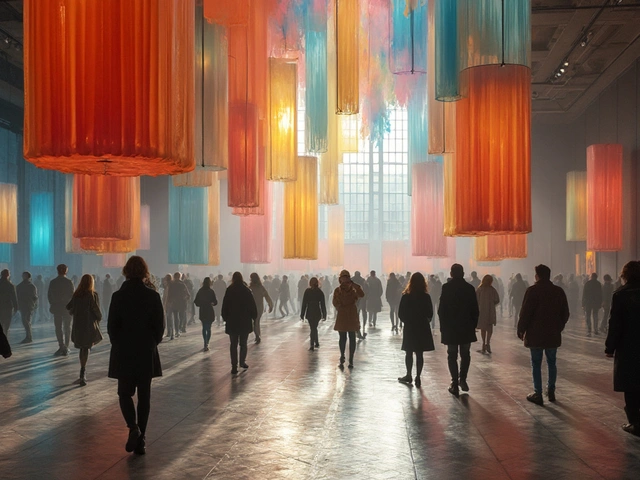The term 'Fluxus' may not be as familiar as 'Impressionism' or 'Renaissance' in the lexicon of art history, yet this movement has played a crucial role in shaping modern art. Born out of a desire to challenge and disrupt the commercialized art world, Fluxus artists embraced an array of materials and methods to express their disdain for the status quo.
At its heart, Fluxus was about blending different artistic media and disciplines, often incorporating elements of music, poetry, and theater. The performances, often unscripted and spontaneous, were fundamental in redefining the role of both the creator and the viewer, making the audience an integral part of the artistic process. It was this innovative approach that set Fluxus apart from more traditional movements, making it a significant, albeit underappreciated, strand of 20th century avant-garde art.
- Origins of Fluxus
- Key Figures and Contributions
- Philosophy and Techniques
- Notable Performances and Works
- Impact on Contemporary Art
- Legacy and Current Relevance
Origins of Fluxus
The roots of Fluxus lie deeply intertwined with a broader narrative of rebellion in early 1960s art. The movement was initially conceived by a diverse group of artists, architects, composers, and designers. These pioneers were united by a common desire to break down the boundaries traditionally imposed by the art world. The inception of Fluxus can be closely linked to Lithuanian-born American artist George Maciunas, who is often credited as being the founding force behind the movement's philosophy and methodologies. Maciunas was instrumental in defining the early workflows and events of what would grow to become a significant anti-art collective.
One of the earliest and most influential events in the history of Fluxus was a series of concerts held in 1961 at the AG Gallery in New York City. These performances showcased experimental works by key figures such as John Cage, whose philosophies and compositions had an enduring influence on Fluxus’s formation. Cage's use of indeterminacy and chance in music and performance meshed well with Maciunas's vision. The collective's early works were marked by a strong sense of anarchical humor and the use of simplistic, mundane objects transformed into art, challenging the rigid constraints of the established art scene at the time.
The movement quickly spread beyond the borders of New York to other parts of the United States and Europe. Collaborations and performances became a staple of Fluxus, characterized by their experimental and participatory nature, which were often executed with a touch of whimsy and mockery directed at the solemnity of the mainstream art world. The term 'Fluxus'—literally meaning 'to flow'—was aptly chosen to represent the unstructured, often ephemeral, and intermedia nature of the artworks produced under its banner.
"Fluxus aimed to remove boundaries, not only among different artistic media but also between artists and the audience. Its legacy is a freer, more democratized art world." - Historian of art
The widespread dispersion of Fluxus was not due to a central management or strategy but rather emerged from a shared attitude toward the meaning and accessibility of art. It drew supporters who were united by common ideals rather than stylistic similarities, encompassing a global network from Europe to Japan. This shared ideology allowed Fluxus to adopt an 'anti-disciplinary' stance that saw traditional disciplines in art as constituents of a single artistic philosophy - the unity of art and life.
Key Figures and Contributions
The Fluxus movement, though broad and encompassing in its scope, was ignited and propelled by a constellation of avant-garde artists, each bringing their own unique perspectives and energies to the collective table. Among these, several stand out for their seminal contributions and pioneering spirit. George Maciunas, often considered the founding father of Fluxus, not only coined the term but also deeply influenced the movement's direction through his organized events and manifestos. Maciunas' vision was to merge art and life, to create an art form that was accessible and could break down the barriers between art and the audience.
Another monumental figure in the Fluxus movement was Yoko Ono, whose performance and conceptual art pieces remain influential to this day. Ono's works, often simple yet profoundly evocative, challenged audiences to engage with the essence of art itself, beyond the confines of traditional media. Her "Cut Piece," a performance where audience members were invited to cut pieces from her clothing while she sat on stage, underscored the themes of vulnerability, trust, and interpersonal dynamics, central to many Fluxus works.
The contributions of Nam June Paik also cannot be overlooked. Known as the founder of video art, Paik brought television into the realm of artistic medium, manipulating electronic visual experiences in a way that no one had before. His work not only expanded the Fluxus movement's reach but also set the stage for future explorations in media art. Paik's installations and performances, integrating televisions and live elements, broke down the barriers between viewer and viewer, technology and human interaction.
Alison Knowles, a Fluxus artist who utilized a variety of media in her work, is celebrated for her event scores, which are sets of written instructions that can be performed by anyone, anywhere, emphasizing the democratic and participatory nature of Fluxus. Her piece "Make a Salad" literally involved her making a salad live as a performance, turning everyday life into an art form, which directly spoke to the foundational tenets of Fluxus.
Philosophy and Techniques
The Fluxus movement was underpinned by a philosophy that was as unconventional as the artworks it produced. Rejecting the traditional commercialized art scene, Fluxus was more than just an artistic movement; it was a social and cultural manifesto. The artists associated with Fluxus believed in making art accessible to all, breaking the elite boundaries that the art world had traditionally maintained. This philosophy was vividly expressed through their use of everyday materials and the inclusion of improvised performances.
One of the core beliefs of Fluxus was the idea of 'intermedia', a term coined by Fluxus artist Dick Higgins to describe the interactivity between different artistic mediums and disciplines. This concept was a direct challenge to the established norms that dictated that different forms of art should not intersect. Fluxus artists frequently blended visual art with music, literature, and dance to create hybrid forms of art that could not be easily classified.
Techniques in the Fluxus movement varied widely but shared common goals: simplicity, spontaneity, and an element of surprise. Everyday objects were transformed into art, which not only democratized the art-making process but also questioned what constitutes art itself. For instance, the event scores, which were simple performance instructions that could be performed by anyone, anywhere, became a hallmark of Fluxus. These scores, often just a few lines long, encapsulated the movement's spirit—artistic expression distilled to its simplest form.
Perhaps, one of the most famous examples of this was Yoko Ono's 'Cut Piece', a performance where she invited the audience to cut away pieces of her clothing, symbolically handing over the control of the artistic process to the audience. This act of engagement highlights the Fluxus commitment to interaction and participation, dismantling the traditional unidirectional flow of art from artist to viewer.
The inclusiveness and simplicity of the Fluxus philosophy continue to influence the art world today. By challenging the distinctions between 'high' art and 'low' art, and between art and life, Fluxus has left a lasting legacy that calls into question the role and definition of art in contemporary society.
Notable Performances and Works
Fluxus, as a movement, was not limited to static paintings or sculptures; it was alive, unpredictable, and dynamic. The art pieces often involved performances and happenings that disrupted the quiet, solemn settings typical of galleries and museums. One of the most characteristic examples of this is Yoko Ono’s 'Cut Piece'. In this performance, which first took place in 1964, Ono invited the audience to come up and cut pieces off her clothing, wearing a garment until it was completely cut down. This performance questioned the role of the viewer in art, challenging the passive consumption of artworks and becoming a powerful commentary on vulnerability and transformation.
Another seminal work within the Fluxus movement was George Maciunas’s 'Fluxkits'. These were small boxes filled with cards, objects, instructional texts, and more, which could be seen as nontraditional art mediums. They encapsulated the Fluxus zeal for makeshifting the mundane into something extraordinary. 'Fluxkits' embodied the DIY, anti-commercial ethos strongly championed by Maciunas and provided a novel, intimate art experience in a portable, interactive format. This redefinition of what could be considered an artistic medium was radical and groundbreaking for the time.
John Cage, a prominent figure associated with Fluxus, challenged the traditional conceptions of music with his piece '4’33”'. In this work, the musician sat by an instrument, ostensibly to play, but remained completely silent for 4 minutes and 33 seconds. Ostensibly devoid of typical musical sounds, '4’33”' instead directed the audience's attention to ambient sounds in the environment, treating them as part of the musical experience. This piece was a direct foray into the heart of sonic experimentation, foregrounding the 'music' present in everyday sounds, often ignored or taken for granted.
One of the more visually arresting pieces was Alison Knowles's 'Make a Salad'. This performance involved the artist creating a large-scale salad by chopping and mixing the ingredients in real-time before an audience. Once the salad was made, it was served to the spectators, transforming viewers into participants. This direct engagement with the audience was emblematic of Fluxus's intent to eliminate barriers between the artist and the public, fostering a communal experience through simple, everyday actions.
Impact on Contemporary Art
The Fluxus movement, though initially seen as radical and on the fringes of the art world, has left an indelible mark on contemporary art. By eschewing traditional formats and mediums, Fluxus artists encouraged a freer, more accessible approach to art-making that has influenced countless artists and movements that followed. This impact is particularly visible in how contemporary art spaces strive to break down barriers between the audience and the artwork, much like Fluxus sought to involve the spectator directly in the creation and experience of art.
One of the core principles of Fluxus—interactivity—has been embraced by modern digital and installation art. Artists today often create works that require viewer participation, a direct lineage from the Fluxus emphasis on 'art as experience' rather than just 'art as an object'. This shift has helped democratize art, making it something that all people can be part of, rather than a passive experience. The ripple effects of this can be seen in everything from street art to interactive urban installations that invite public engagement.
Furthermore, the Fluxus movement's use of everyday objects in art pieces has paved the way for environmental art and recycled art forms. By demonstrating that anything could be art, and anyone could be an artist, Fluxus challenged the definition of art itself. This idea has encouraged modern artists to explore more sustainable practices, utilizing non-traditional materials and themes that critique consumerist culture and environmental issues. It’s a testament to how Fluxus has not only influenced art forms but also the thematic concerns of contemporary art.
In addition, Fluxus's integration of performance in art has significantly shaped the development of performance art as a standalone genre. It is not uncommon now to see exhibitions that primarily feature performance instead of static works, underscoring how the performative aspects touted by Fluxus have continued to resonate through the decades. Art, in the view of Fluxus artists, was as much about process and experience as it was about the final product — a viewpoint that continues to influence artistic practices today.
The legacy of Fluxus is also evident in how art is taught and discussed in academic institutions. Many contemporary art curricula now emphasize process over product, creativity over skill, and conceptual ideas over technical execution. This aligns closely with the Fluxus ideology that art should be experimental and boundary-pushing, rather than conforming to traditional norms and standards.
Legacy and Current Relevance
The legacy of Fluxus continues to resonate through the corridors of contemporary art, influencing new generations of artists who seek to challenge traditional modes of expression. Even today, the echoes of Fluxus can be found in performance art, guerrilla theater, and in the practices of artists who blend life with art, much like their Fluxus predecessors. The movement's emphasis on inclusivity, interactivity, and the demystification of the art process led to a seismic shift in how art could be created and appreciated, making it accessible to everyone, not just the elite in the art world.
Not only did Fluxus inspire methods and concepts in the visual arts, but it also made a significant mark in music and sound art. Artists such as Yoko Ono and Nam June Paik, key figures in the movement, showcased how sound could serve as a vehicle for artistic expression outside conventional frameworks. Their work paved the way for contemporary experimental musicians and sound artists who continue to push the boundaries of what can be considered music and art.
In the realm of digital media, the Fluxus spirit can be seen in how artists use technology to create interactive experiences that engage the audience directly—an idea that Fluxus artists championed with their event-scores and happenings. Technology, much like the simple, everyday materials Fluxus artists favored, has become another tool for breaking down the barriers between the artist and the audience, between art and life.
Moreover, the philosophy of Fluxus, centering on the idea that art can be made by anyone and can come from anything, is a powerful reminder of the democratic nature of creation. It challenges current artists to think outside the traditional confines of the art market and explore art in its most expansive forms. It stands as a testament to creativity unrestricted by conventional norms and encourages a free exchange of ideas amidst an ever-commercializing contemporary art scene.
Current relevance of Fluxus is not just an echo of the past but a living, breathing inspiration for both art and social interaction. By breaking down the barriers that separated high art from the everyday, Fluxus questioned the very essence of what it means to be an artist. For today's creatives, especially those working outside traditional institutions, Fluxus offers a blueprint for artistic resistance and innovation.




